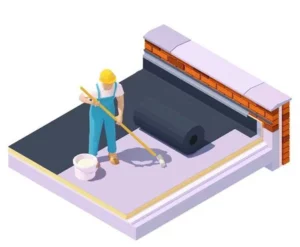Project Report For Water Proofing Service
Introduction
Project report for Water Proofing Service is as follows.
Waterproofing is the process of making an object or structure waterproof or water-resistant so that it is relatively unaffected by water or resists water infiltration under certain conditions. These things can be employed in damp situations or at specific.
Waterproofing maintenance entails chemical and structural treatments to keep liquid from eroding critical surfaces (primarily concrete). While certain waterproofing methods can be performed independently, construction and restoration professionals have specific training for industrial or large-scale building needs. Aside from evident symptoms of cement degradation, specific techniques must be used to ensure both worker and environmental safety. Make use of reputable pros!

Product & its Application Of Water Proofing Service
Water proofing is done differently for different type of water proofing. Some of the examples are as under.
Leak proofing process, Terrace Chemical proofing process as follows :
A) Polymer Acrylic cementitous chemical coating
B) Poly acrylic cementitous Sandwich textile membrane chemical coating
C) Acrylic waterproof chemical coating
D) Tar-based waterproof Liquid membrane chemical coating
E) Polyurethane waterproof chemical coating
F) Rubberized waterproof chemical coating We use all the products with advance technology.
DAMP PROOFING: There are two types of dampness. Dry and wet, use the silicone gel chemical process to treat affected walls, followed by a damp proof chemical coat.
Project Report Sample On Water
Proofing Service
Proofing Service
Get Completely Custom Bankable Project Report
Raw Material Requirement Of Water Proofing Service
Crystalline admixtures: Crystalline-based systems are hydrophilic and often arrive in a dry, powdered form. Unlike its hydrophobic competitors, crystalline systems create crystals inside concrete using available water, successfully sealing off moisture channels that can damage the material. They prevent water from entering from any direction because the concrete itself acts as a water barrier. When demolition happens, the crystalline formula has no VOCs and can be totally recycled.
Crystalline admixtures also have benefits for installation. Crystalline admixtures can be shipped in dissolvable, pulpable bags that are thrown into the concrete batch during mixing, in contrast to traditional membrane waterproofing, which is frequently labor- and cost-intensive.
Combining steps with concrete placement shortens the building schedule and lowers labour costs. Applications with continuous movement shouldn’t employ integral crystalline waterproofing systems. Crystals align in a three-dimensional array during the crystallisation process, which fractures with excessive motion.
It might be better to waterproof areas that need flexibility and experience frequent movement, such plaza decks or rooftops, in a different approach.
Market Potential Of Water Proofing Service
The size of the world market for waterproofing membranes was estimated at USD 22.1 billion in 2021 and is projected to increase at a CAGR of 6.9% from 2022 to 2030.
Expenses

Product Cost Breakup

Reveneue Vs Expenses

Market Trend

The market is expected to rise as a result of rising demand from the waste and water management industry and expanding water conservation infrastructure construction. Wet rooms, roofs, sewage treatment facilities, retaining walls, building foundations, tunnels, and water are just a few of the places where waterproofing membranes are used.
The adoption of innovative materials like geomembranes and growing consumer awareness of the benefits of the products are predicted to further boost demand for the products for the foreseeable future.
The market for waterproofing membranes was led by the liquid-applied membrane product segment in 2021, which also had the highest revenue share of more than 63.0%. The expansion can be ascribed to increased consumer awareness of the product’s benefits, including simplicity of installation and cost-effectiveness.
The need for liquid-applied membranes is also anticipated to increase in the near future due to expanding worldwide infrastructure for water treatment and conservation. Revenue growth for polyurethane liquid applied membrane is predicted to increase significantly throughout the projection period by 8.8%. It has a constant thickness, making use in a variety of applications simple.

